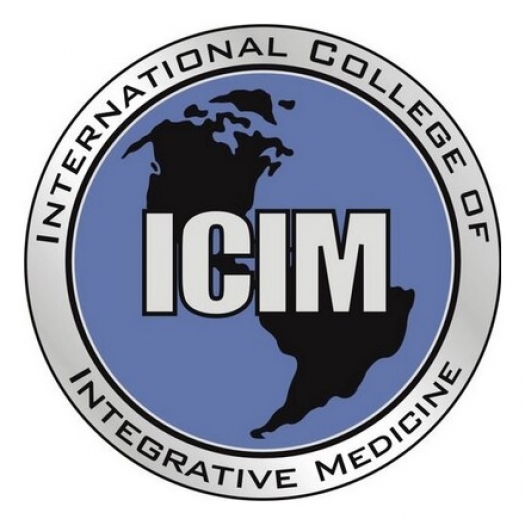An Orthomolecular Approach to Cancer
icimlogo.jpg

International College of Integrative Medicine
The International College of Integrative Medicine (ICIM) is a not-for-profit medical organization that seeks to teach the latest research in preventative, alternative, and innovative treatments.
Their members are physicians who are comfortable treating health concerns relating to circulation, the brain, the immune system, hormones, digestion, pain, and/or toxicity. They are health professionals who are interested in utilizing more than just drugs or surgical procedures in the holistic care of our patients.
Through their conferences and advanced-level trainings, they seek to fulfill their mission of providing physicians with a comprehensive understanding of integrative medical care. To that end, FAIM is reporting on several of the presentations given at their 2018 conference in Minneapolis entitled An Orthomolecular Approach to Cancer.
This conference included an array of expert speakers on a variety of topics including:
- Paul Anderson, ND — Oncology and Orthomolecular Medicine
- Michael J Gonzalez, PhD — Targeting the tumor microenvironment for cancer prevention and therapy
- Jen Green, ND — Evaluating & Treating the Oncology Terrain
- Joe Hickey, MD — Carcinogenic Qualities of Metals
- Ron Hunninghake, MD — RECNAC III – Revisiting the Future
- Virginia Osborne, ND — Integrative Integration and the Individual
- Greg Plotnikoff, MD — Trust Your Gut
- Greg Plotnikoff, MD — Microbial Production of Butyrate: Histone Deacetylation and Cancer
- Angela Poff, PhD — Exploiting Cancer Metabolism with Ketosis
- Christine Salter, MD — Integrative Approach to Treating the Patient with Breast Cancer
- Tom Wagner, PhD — Historical Perspective on the Innate Immune System
In addition, FAIM is reporting on the following four presentations with an in depth summary. This is just a sample of the incredible knowledge that is shared at the ICIM conferences. If you are interested in learning more, please visit the Integrative Medicine website.
John Parks Trowbridge, MD
Deep Blood Fungus: Dental and other Connections to Devastating Illnesses
What is the difference between Deep Blood Fungus and Yeast Syndrome? Deep Blood Fungus is indicative of chronic and serious illness. Yeast Syndrome is not as serious or pervasive. Our bodies are filled with fungus of all types. Most often they are beneficial and create an avenue of communication. However, a few fungi can cause disease and illness. Compromised patients from HIV, cancer, corticosteroids, immunosuppressants, frequent antibiotics, chronic dental infections, nutritional deficiencies, toxic chemicals, toxic metals, hormone imbalances, stress, etc. can be at risk offering an environment which will encourage pathogenic fungus to thrive. When fungi is present in the body, it can be systemic in the internal organs, or superficial showing up in the skin, nails, or hair. Dr. Trowbridge is a true expert in the field having published The Yeast Syndrome in 1986. In his book he outlines how a person can avoid attack by pathogenic fungus by keeping the gut healthy, and protecting the lungs and sinus cavities. All of these avenues are important as these molds and fungi are often introduced into the body through inhaling, ingesting or through the skin.
Patients with Deep Blood Fungus will present with rheumatoid arthritis, lupus, ALS. MS, Leukemia and other cancers, severe skin disorders, unexplained immune disorders, recurrent infections, etc. Dr. Trowbridge finds it vital to treat the fungus initially in order to begin to resolve these serious imbalances in the body. He uses drugs (for instance Rapamycin), and in addition he also uses natural supplements including astaxanthin (especially for MS), resveratrol and Regrapex-R-Forte (for biofilm issues), and stilbenoids as antimicrobial therapy. Terminalia chebula tree is an effective antibacterial, antifungal, and antiviral. Turmeric/curcumin reduces the fungal burden and is synergistic when combined with five azole and two polyene drugs. Curcumin when combined with Vitamin C is especially effective against candida. One can also create synergy using oregano, Pau d’Arco, cloves, black walnut, olive oil, tea tree, goldenseal, calendula, spearmint and neem as the polyphenols play an important role. The terpenes in essential oils are beneficial
When there is an injury in the body it opens the door for infections and opportunistic fungal infections. Dr. Trowbridge recommends many things to incorporate into daily living including: using tooth soap when brushing the teeth, flossing, drinking plenty of water, eating the rainbow, eating quality protein, taking supplements, supporting the gut, getting adequate sleep, reducing stress, using ozone, getting plenty of oxygen, and enjoying life. Things to avoid include consuming sugar, smoking, alcohol, toxic chemicals, food additives and prescription drugs.
Candida auris is a very dangerous fungus that is drug resistant, causing serious invasive infections. This was discovered in 2009 and found in hospital settings. It is one to know about and beware of. In summary he encourages the public to visualize that our bodies are our space suits to protect us from invasion of pathogenic microbes and support our immune system.
Walter Lemmo, ND
Low-Dose IVC and DMPS in Platinum Chemotherapy
Dr. Lemmo presented a talk on the benefits of using low dose Vitamin C IV in the treatment of cancer. His research and practical experience in his clinic has proven that lower dose IV Vitamin C can be superior in outcome of plasma protection to using high doses. An infusion of 15-25 grams Vitamin C increases antioxidant capacity of the plasma and adds protection time. The research emphasizes that low continuous dosing opposed to intermittent administration is superior. It is found to balance the HPA axis, address anemia and is a major player in sepsis. FAIM has reported on the protocol for sepsis using Vitamin C, Thiamine and hydrocortisone. See: Interview with Dr. Paul Marik on Vitamin C Protocol for Sepsis .
When using a high dose, the body eliminates it efficiently and fairly rapidly. It seems the low dose stays in the body longer. Again, as mentioned above, there are synergistic therapies using Vitamin C along with other agents such as gemcitabine. The bottom line is the patient feels better. IV vitamin C is also used when administering hyperthermia, a common therapy in European clinics.
DMPS is a chelating agent that helps remove the platinum that exists with many chemotherapy agents. There are many long term platinum side effects including hearing loss, tinnitus, high blood pressure, neuropathy, cardiovascular issues, thyroid diseases, depression, Gastrointestinal cancer to name a few. DMPS can help reduce the platinum load and help resolve these serious issues.
For more information, visit the LEMMO Integrated Cancer & Care Centre website.
Akbar Khan, MD
Is Chemotherapy Overrated? Metabolic Therapy with DCA and DMSO as an Alternate Approach
DCA is a metabolic therapy actin as an enzyme inhibitor and starving the cancer. The end result is apoptosis (death) of the cancer cell. Dr. Kahn presented several case studies of patients given 3 months to live, treated with DCA and alive 9 years later. It is vital to be cognoscente of the dosing as there are side effects from DCA including neuropathy, tremors, memory loss and nausea. However once the drug is discontinued the side effects resolve. In order to protect against neurological side effects, the doctor should give neuroprotective supplements such as CoQ10. DCA can also be effective for heart failure, angina, renal failure and lowers blood sugar levels.
In Dr. Khan’s clinic they have seen a 60% partial response using DCA that was measurable compared to patients who did not receive DCA but found it is dose dependent and it was necessary to balance benefit verses side effects (enhanced by the use of natural supplements).
In summary, 1) DCA can be used to treat any type of cancer including chemo resistant cancers; 2) there were no life threatening side effects; 3) it was not immunosuppressive; 4) it was not myelosuppressive; 5) it worked best in combination with other therapies; 6) QOL benefits were significant; 7) Cyclic therapy appears to be most effective; 8) side effects can be moderated using IV therapy.
DMSO is dimethyl sulfoxide and is derived naturally from trees. It is used to treat cancer, inflammation, cerebral edema, etc. It is capable of crossing the blood/brain barrier, is a preservative for bone marrow in transplant applications and is a potential carrier for chemotherapy. The side effects of using DMSO are minimal but do include nausea, headache and a garlic like odor on the body. DMSO can be used IV or topical. DCA and DMSO are effective and safe for human use based on human publications and clinical experience.
Overall, metabolic therapies are effective and appropriate. If there is an argument that “evidence based therapies are superior” the fact is that these therapies are largely unproven, can be harmful, and often ineffective. Statistics show that using cytotoxic chemotherapy has a 2.1% survival rate in adults over 5 years. New chemo drugs are offering, at most, 3 additional months of survival in comparison to a total remission. It is beneficial to look into metabolic therapies for the future of cancer care and treatment.
David Brownstein, MD
Iodine: The Universal Anti-Cancer Therapy
David Brownstein, MD, is the author of the book Iodine: Why You Need It. Iodine is an essential element for glandular tissues. When iodine is low, cysts develop and ultimately can become cancerous. Iodine can reverse this scenario. Low iodine causes an increase in Thyroid Stimulating Hormone which, in turn, causes hyperplasia of the thyroid and can lead to cancer of the thyroid. Iodine thus can inhibit thyroid cancer.
We are seeing more cancer in young people now days and often these forms are aggressive. In the case of breast cancer, iodine is stored in the breast. When it is deficient the breast tissue is altered, leading to fibrocystic breast disease. This can also be a precursor to cancer. Since salt is essential in the transport of iodine, adequate quality salt (not Mortens) is essential. The iodine is an alkalizer and antioxidant and changes the tissue from pathological to normal. The fact that iodine is needed to metabolize estrogen in the body makes it especially relevant with the use of so many xenoestrogens in our environment and bodies. Unfortunately the facts relate that 97% of young women are iodine deficient which could be a factor in the increase of breast cancer statistics. As an example, Japanese women receive almost 14 mg per day of iodine just through diet and they have a much lower breast cancer rate than women in the United States.
Autism is much higher in iodine deficient areas on the planet. Our environment is contaminated with bromide which competes with iodine at a cellular level, ultimately creating an iodine deficiency. It is found that breast cancer patients have higher levels of bromide.
Iodine is also relevant in prostate cancer. Again Japanese men, who get more iodine in their diet, have a prostate cancer rate that is ten times lower than in the United States. Iodine and Iodide together are effective in preventing prostate hyperplasia.
Testing for iodine levels can be done using the Iodine Loading Test. For this test, the first morning urine is discarded. The patient ingests 50 mg of iodine/iodide. The urine is collected for 24 hours. Iodine excretion is measured. A 90% excretion level is considered normal. Lugol solution is suggested by Dr. Brownstein. Four drops per day delivers approximately 25 mg.
There is a continuing argument as to whether iodine causes autoimmune thyroid disease presenting as Hashimoto’s or Graves’ disease. The presenter explained that this must not be true because iodine levels have fallen 50% over the last 40 years and Hashimoto’s and Graves’ disease have increased at a rapid rate during that time.


